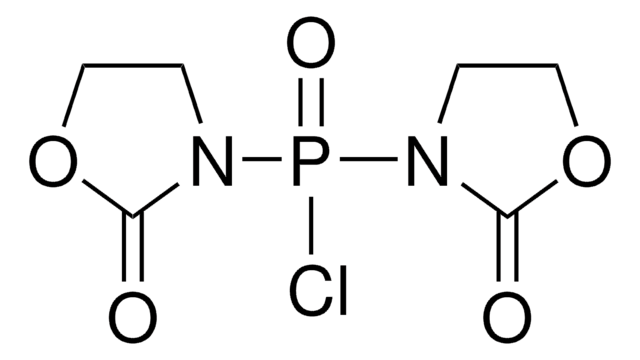Kluczowe dokumenty
472565
Diethyl cyanophosphonate
90%
Synonim(y):
DEPC, Diethyl phosphoryl cyanide
About This Item
Polecane produkty
Próba
90%
współczynnik refrakcji
n20/D 1.403 (lit.)
bp
104-105 °C/19 mmHg (lit.)
gęstość
1.075 g/mL at 25 °C (lit.)
temp. przechowywania
2-8°C
ciąg SMILES
CCOP(=O)(OCC)C#N
InChI
1S/C5H10NO3P/c1-3-8-10(7,5-6)9-4-2/h3-4H2,1-2H3
Klucz InChI
ZWWWLCMDTZFSOO-UHFFFAOYSA-N
Szukasz podobnych produktów? Odwiedź Przewodnik dotyczący porównywania produktów
Opis ogólny
Zastosowanie
Inne uwagi
Hasło ostrzegawcze
Danger
Zwroty wskazujące rodzaj zagrożenia
Zwroty wskazujące środki ostrożności
Klasyfikacja zagrożeń
Acute Tox. 2 Dermal - Acute Tox. 2 Inhalation - Acute Tox. 2 Oral - Eye Dam. 1 - Skin Corr. 1B
Zagrożenia dodatkowe
Kod klasy składowania
6.1A - Combustible acute toxic Cat. 1 and 2 / very toxic hazardous materials
Klasa zagrożenia wodnego (WGK)
WGK 3
Temperatura zapłonu (°F)
176.0 °F - closed cup
Temperatura zapłonu (°C)
80 °C - closed cup
Środki ochrony indywidualnej
Faceshields, Gloves, Goggles, type ABEK (EN14387) respirator filter
Wybierz jedną z najnowszych wersji:
Masz już ten produkt?
Dokumenty związane z niedawno zakupionymi produktami zostały zamieszczone w Bibliotece dokumentów.
Klienci oglądali również te produkty
Active Filters
Nasz zespół naukowców ma doświadczenie we wszystkich obszarach badań, w tym w naukach przyrodniczych, materiałoznawstwie, syntezie chemicznej, chromatografii, analityce i wielu innych dziedzinach.
Skontaktuj się z zespołem ds. pomocy technicznej

















